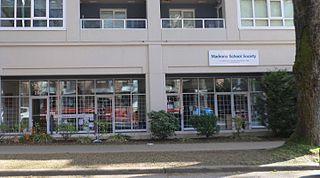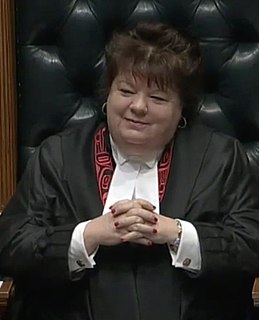
Education in Canada is for the most part provided publicly, and is funded and overseen by provincial, territorial and local governments. Education is within provincial jurisdiction and the curriculum is overseen by the province. Education in Canada is generally divided into primary education, followed by secondary education and post-secondary. Within the provinces under the ministry of education, there are district school boards administering the educational programs.

Secondary education in the United States is the last seven years of statutory formal education grade 6 through grade 12. It occurs in two phases. The first is the ISCED lower secondary phase, a junior high school or middle school for students grade 6 through grade 8. The second is the ISCED upper secondary phase, the high school for students grade 9 through grade 12. There is some debate over the optimum age of transfer, and variation in some states.
Gifted education is a broad group of special practices, procedures, and theories used in the education of children who have been identified as gifted or talented.
State schools or public schools are generally primary or secondary schools that educate all children without charge. They are funded in whole or in part by taxation. State funded schools exist in virtually every country of the world, there are significant variations in their structure and educational programmes. State education generally encompasses primary and secondary education. <--Use USCED stages for more clarity -->

Gleneagle Secondary School, or simply Gleneagle, is a public coeducational high school located in Coquitlam, British Columbia, established in 1997. It is run by School District 43 Coquitlam. Gleneagle serves grades 9-12 and has an enrolment of about 1500 students. In addition to academic programs, Gleneagle offers specialty programs such as ACE-IT Culinary Arts and Hairdressing, the COAST outdoor education program, the grade 9 JumpstART art program, and the school district's TALONS gifted program.

Richmond Secondary School, is a public, co-educational secondary school located in Richmond, British Columbia, Canada, that educates approximately 1200 students from grades 8 to 12. Richmond Secondary is the only school in Richmond that offers the International Baccalaureate Diploma Programme and is a magnet school in the region.

Madrona School Society is a not-for-profit independent school located in Vancouver, British Columbia, with a focus on gifted education. Subjects are taught in small groups based on students' ability levels. On average, the student-teacher ratio is between 6:1 and 14:1. Currently, the school offers Kindergarten through Grade 9.

École Gabrielle-Roy is a French first language elementary and high school in Surrey, British Columbia, Canada. It serves the francophone population of the Greater Vancouver Regional District. The school was built at the new location after the previous one burned down due to a fire started by fireworks in the school's library. The school is named in honour of French Canadian author Gabrielle Roy. École Gabrielle-Roy now has the International Baccalaureate Intermediate and Diploma programs for grades 7 to 12.

Robert Cecil Palmer Secondary School, is a public, co-educational secondary school situated in Richmond, British Columbia, Canada which educates students in grades 8-12. Palmer Secondary School is one of the many schools under the Richmond School District. It is the only school in Richmond to offer the Pre-AP Incentive Program, the ACE-IT plumbing program and, previously, the Palmer Hockey Academy. The Richmond Virtual School is also hosted in the Palmer building.

Holy Cross Regional High School, or "HCRHS", is a Catholic school, under the administration of CISVA school board located in Surrey, British Columbia, Canada.
St. Francis Xavier School is an Independent Catholic School of the Vancouver Archdiocese. S.F.X. was ranked number one in "Report Card on British Columbia’s Elementary Schools" by The Fraser Institute in the 2008 edition. The school is a dual stream elementary school, established by St. Francis Xavier Parish in 1933, and it follows the policies and procedures recommended by the CISVA. The school enrolment consists of 440 students with a class size of approximately 28 students. St. Francis Xavier School offers education from Kindergarten through to Grade 7. The school was originally located near Chinatown but is now located north of Mount Pleasant. The current principal is Brian Fader.
Meadowridge School, located in Maple Ridge, British Columbia, is a coeducational, independent school teaching Junior Kindergarten through to Grade 12.
Education in Ontario comprises public and private primary and secondary schools and post-secondary institutions. Publicly funded elementary and secondary schools are administered by the Ontario Ministry of Education, while colleges and universities are administered by the Ontario Ministry of Training, Colleges and Universities. The current respective Ministers for each are Stephen Lecce and Ross Romano. The province's public education system is primarily funded by the Government of Ontario, with education in Canada falling almost entirely under provincial jurisdiction. There is no federal government department or agency involved in the formation or analysis of policy regarding education for most Canadians. Schools for Indigenous people in Canada with Indian status are the only schools that are funded federally, and receive greater funding than provincial public schools.

Linda Reid is a Canadian politician. She was Minister of Advanced Education and a Speaker of the Legislative Assembly of British Columbia. She was first elected in 1991 to represent the riding of Richmond East and was re-elected in 1996, 2001, 2005, 2009, 2013. Reid served as Minister of State for Childcare from June 2005 to June 2009 and the Minister of State for Early Childhood Development from June 2001 to June 2005. She also served as the Deputy Speaker from 2009 until 2013.

Higher education in British Columbia is delivered by 25 publicly funded institutions that are composed of eleven universities, eleven colleges, and three institutes. This is in addition to three private universities, five private colleges, and six theological colleges. There are also an extensive number of private career institutes and colleges.

The University Transition Program, often called the Transition Program, UBC Transitions, UTP, or simply Transition, is an early college entrance program funded by the Vancouver School Board, the University of British Columbia and the BC Ministry of Education that is based in the University of British Columbia in Vancouver, British Columbia, Canada. Each year, the program accepts around 20 new students between the ages 12 and 15, half of which are from outside the Vancouver School District. This is out of approximately 200 applicants; rigorous testing must be performed to select acceptable candidates. Over the course of two years, students aim to complete the required high school curriculum along with some university level coursework. When they graduate from the program, the students usually are accepted into UBC earlier than they would if they had graduated from a regular high school. The program was first established in 1993 by the Vancouver School Board, British Columbia Ministry of Education and the University of British Columbia. Students of the program have access to most UBC facilities and possess UBC undergraduate student cards. The program held its 20th anniversary on May 15–17, 2015.
St. Ann's Academy is a Catholic school, under the administration of CISKD school board.
Az-Zahraa Islamic Academy is an independent Pre-school through Grade 7 school in Richmond, BC.

An elementary school is a primary school which is the main point of delivery of primary education in the United States, for children between the ages of 5–11 and coming between pre-kindergarten and secondary education.
A high school diploma is a North American academic school leaving qualification awarded upon high school graduation. The high school diploma is typically obtained after a course of study lasting four years, from grade 9 to grade 12. The diploma is awarded by the school in accordance with the requirements of the local state or provincial government. Requirements for earning the diploma vary by jurisdiction, and there may be different requirements for different streams or levels of high school graduation. Typically they include a combination of selected coursework meeting specified criteria for a particular stream and acceptable passing grades earned on the state exit examination.














